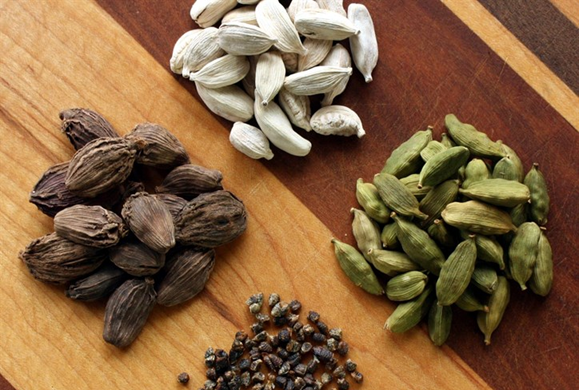What type of cardamom to use when?
May 13, 2025 by DarcieDo you remember the first time you tasted cardamom? Perhaps it occurred when you nibbled on Swedish meatballs or drank masala chai. Cardamom’s enchanting flavor has made a home for itself in cuisines across the globe. Since there are several types available, it can be difficult to know which is most suited for a particular dish. In a recent Kitchen Aide article at The Guardian, Anna Berrill breaks it down for us with an explanation of the main cardamom variations.

Cardamom is a member of the ginger family, and like its cousin, it possesses a warm, sweet fragrance with citrus and floral notes underpinned by hints of eucalyptus. The outer shells of cardamom pods have little flavor; the intense taste is found in the tiny inner seeds. Properly stored, cardamom pods will stay fresh indefinitely. Shelled (decorticated) cardamom seeds are less expensive but don’t keep as well. Ground cardamom is easy to use in baking applications, but as with most ground spices, its flavor diminishes quickly. Ground cardamom should be a dark brown color; lighter colored powders include the ground pods and are not as flavorful.
Although there is a red cardamom, the two most common types you will encounter in recipes are green and black/brown. Black cardamom is not considered “true” cardamom and the flavor profile varies considerably. The black pods are much larger and the seeds have a woodsy, smoky scent with camphor undertones, which means it is not interchangeable with the green variety. According to author Roopa Gulati, black cardamom is deeper, smokier, and carries a bigger punch. Roopa says that you “have to be aware that they are totally different in flavour. You’re not going to make a lovely, aromatic rice pudding and stick some brown cardamom in it, because that will override all the other flavours.”
One of the world’s most expensive spices, cardamom ranks just behind saffron and vanilla in cost, sharing their persnickety growing conditions and laborious hand-harvesting requirements. The seed pods do not ripen all at once, so the harvest season stretches for months, with skilled workers plucking only pods that are almost completely ripe (when fully ripe, the pods explode and the seeds scatter everywhere). Even though cardamom is native to the Indian subcontinent, Guatemala now ranks as the world’s largest producer of the spice.
We haven’t yet mentioned white cardamom, and the article doesn’t delve into this variation of the spice. The story behind white cardamom is one of technology replicating an obsolete process. When cardamom was first exported to ports far from its native lands, the poor storage conditions on the ships would expose the pods to sun, salt, and air, causing the color (and flavor) to fade. Old habits die hard, so now cardamom is artificially bleached to meet consumer expectations for a milder, mellower flavor. You may substitute green for white cardamom in any recipe.
Categories
- All Posts (7144)
- Antipasto (2236)
- Author Articles (253)
- Book News (948)
- Cookbook Giveaways (1003)
- Cookbook Lovers (265)
- Cooking Tips (118)
- Culinary News (301)
- Food Biz People (561)
- Food Online (805)
- Holidays & Celebrations (280)
- New Cookbooks (156)
- Recipes (1531)
- Shelf Life With Susie (231)
- What's New on EYB (138)
Archives
Latest Comments
- Meredythhaas on Persiana Easy – Cookbook Giveaway
- demomcook on TL;DR
- dmass on TL;DR
- Indio32 on TL;DR
- MollyDT on A love letter to Sift by Nicola Lamb with a giveaway
- colleenmv on Pull Up a Chair – Cookbook Giveaway
- colleenmv on So Easy So Good Cookbook Giveaway
- colleenmv on The Salad Lab Cookbook Giveaway
- colleenmv on A love letter to Sift by Nicola Lamb with a giveaway
- colleenmv on Potluck Desserts Giveaway, Quick Bites and Recipes